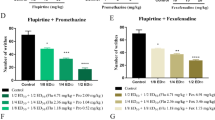Abstract
Rationale
Little information is available about the interaction between dihydrocodeine and second-generation antihistamine drugs such as cetirizine and ebastine, with particular reference to the rewarding effect of dihydrocodeine.
Objective
The effects of second generation histamine H1 antagonists, such as cetirizine and ebastine on the antitussive and rewarding effect of dihydrocodeine were examined in mice.
Methods
Mice were exposed to a nebulized solution of capsaicin (30 µmol/l) under conscious and identical conditions, using a body plethysmograph. The coughs produced during a 3-min exposure period were counted. Effects of H1 antagonists on the reinforcing effect of dihydrocodeine were assessed by using the conditioned place preference procedure in mice.
Results
The antitussive effect of dihydrocodeine was enhanced by the simultaneous administration of either cetirizine or ebastine. There was no statistical difference between the ED50 of dihydrocodeine in combination with ebastine and that of dihydrocodeine in combination with cetirizine. Concurrent dosing of dihydrocodeine and ebastine produced a significant place preference. This behavioral potentiation was antagonized by SCH23390, a dopamine D1 antagonist. Moreover, ebastine enhanced the central dopamine turnover ratio, but cetirizine could not, in this study.
Conclusion
Taken together, the potentiation of place preference of dihydrocodeine with ebastine may be due, at least in part, to stimulation of the central dopaminergic system via D1 receptors. However, combination of dihydrocodeine with cetirizine does not potentiate place preference at all, nor does it potentiate the central dopaminergic system. Thus, it is likely that cetirizine may be a useful constituent in opioid-containing, antitussive preparations that would not potentiate the development of psychological dependence.


Similar content being viewed by others
References
Andersen PH (1987) Biochemical and pharmacological characterization of [3H]GBR12935 binding in vitro to rat striatal membranes: labeling of the dopamine uptake complex. J Neurochem 48:1887–1896
Coyle JT, Snyder SH (1969) Antiparkinsonian drugs: inhibition of dopamine uptake in the corpus striatum as a possible mechanism of action. Science 166:899–901
Kamei J, Ohsawa M (1996) Effects of diabetes on methamphetamine-induced place preference in mice. Eur J Pharmacol 318:251–256
Kamei J, Iwamoto Y, Suzuki T, Misawa M, Nagase H, Kasuya Y (1993) Antitussive effects of naltrindole, a selective δ-opioid receptor antagonist, in mice and rats. Eur J Pharmacol 249:161–165
Kamei J, Iwamoto Y, Suzuki T, Misawa M, Nagase H, Kasuya Y (1994) Antitussive effects of dihydroetorphine in mice. Eur J Pharmacol 260:257–259
Kamei J, Morita K, Ohsawa M, Onodera K (1999) Effects of epinastine on the antitussive and rewarding effects of dihydrocodeine in mice. Meth Find Exp Clin Pharmacol 21:663–668
Matsunaga K, Sato M, Shuto H, Tsuruta Y, Suemaru K, Gomita Y, Oishi R (1998) Inhibition of neuronal dopamine uptake by some antiallergic drugs. Eur J Pharmacol 350:165–169
Suzuki T, Masukawa Y, Misawa M (1990) Drug interactions in the reinforcing effects of over-the-counter cough syrups. Psychopharmacology 102:438–442
Suzuki T, Masukawa Y, Shiozaki Y, Misawa M (1991) Potentiation of pentazocine conditioned place preference by tripelennamine in rats. Psychopharmacology 105:9–12
Tallarida RJ, Murray RB (1987) Manual of pharmacological calculations with computer program. Raven Press, New York, pp 3–166
Tani N, Kaneko S, Minamikawa S, Miki H, Haga H (1984) A clinical study of SS-BRON solution-W dependency. Jpn J Alcohol Depend 19:205–210
Tuomisto J, Tuomisto L (1980) Effects of histamine and histamine antagonists on the uptake and release of catecholamines and 5-HT in brain synaptosomes. Med Biol 58:33–37
Ueyama K, Tominaga H, Matsumoto K, Nakae T (1984) A case of hallucinatory-paranoid state induced by chronic methylephedrine addiction. Kyushu N-Psych 30:412–415
Author information
Authors and Affiliations
Corresponding author
Rights and permissions
About this article
Cite this article
Kamei, J., Morita, K., Miyata, S. et al. Effects of second generation of histamine H1 antagonists, cetirizine and ebastine, on the antitussive and rewarding effects of dihydrocodeine in mice. Psychopharmacology 166, 176–180 (2003). https://doi.org/10.1007/s00213-002-1359-9
Received:
Accepted:
Published:
Issue Date:
DOI: https://doi.org/10.1007/s00213-002-1359-9




